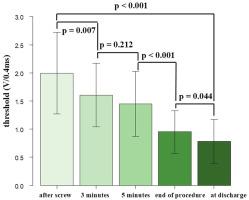右心房无腔导联起搏阈值的改善随时间变化
IF 2.5
Q2 CARDIAC & CARDIOVASCULAR SYSTEMS
引用次数: 0
摘要
背景传统的起搏器植入术往往存在风险,例如在右心房阑尾(RAA)处放置心房导线时会造成穿孔。近来,输送导管的进步使心房导线能够放置在右心房隔膜内,从而有可能减轻与右心房阑尾相关的并发症。本研究旨在评估无腔导联作为心房导联的性能。方法连续招募了 44 名使用无腔心房导联接受起搏器植入术的患者。使用 3830 SelectSecure 导联和 C315HIS 鞘进行导联植入。结果随着时间的推移,包括 P 波、起搏阈值和阻抗在内的导联参数显著改善。拧紧螺钉后,阈值从2.00 ± 0.72 V/0.4毫秒降至5分钟后的1.45 ± 0.57 V/0.4毫秒,手术结束时为0.95 ± 0.38 V/0.4毫秒,出院时为0.78 ± 0.39 V/0.4毫秒。最初,15 例患者的阈值水平为 2.5 伏/0.4 毫秒,但在手术结束时降至 2 伏/0.4 毫秒。出院时,15 例病例中有 13 例的阈值降至 1 V/0.4 毫秒。在随访期间,未观察到阈值升高(1 V)、导联修正或电池耗尽的情况。因此,当拧紧后阈值较高时,等待一段时间而不是立即重新定位导联可能会更有效。本文章由计算机程序翻译,如有差异,请以英文原文为准。

Time-dependent improvements in pacing thresholds with lumenless leads placed in the right atrium
Background
Traditional pacemaker implantation often poses risks, such as perforation when positioning atrial leads at the right atrial appendage (RAA). Recent advancements in delivery catheters have enabled atrial lead placement in the right atrial septum, potentially mitigating RAA-related complications. However, the performance of lumenless leads in this context remains unclear.
Objective
This study was performed to assess the performance of lumenless leads as atrial leads.
Methods
Forty-four consecutive patients undergoing pacemaker implantation with lumenless atrial leads were enrolled. Lead implantation was performed using a 3830 SelectSecure lead and C315HIS-sheath. Pacing parameters were collected immediately after screwing, 3 and 5 minutes later, at the end of the procedure, and at every 6-month follow-up.
Results
Lead parameters including P-wave, pacing threshold, and impedance significantly improved over time. The threshold levels from 2.00 ± 0.72 V/0.4 msec immediately after screwing to 1.45 ± 0.57 V/0.4 msec at 5 minutes, 0.95 ± 0.38 V/0.4 msec at the end of the procedure, and 0.78 ± 0.39 V/0.4 msec at discharge. Initially, threshold levels were >2.5 V/0.4 msec in 15 cases; however, they decreased to <2 V/0.4 msec by the end of the procedure. At discharge, 13 of the 15 cases showed a threshold decrease to <1 V/0.4 msec. During follow-up, no threshold increase (>1 V), lead revision, or battery depletion was observed.
Conclusion
Lumenless lead placement in the right atrium results in threshold decrease over time. Therefore, allowing a waiting period instead of immediately repositioning the lead may be more effective when thresholds are high after screwing.
求助全文
通过发布文献求助,成功后即可免费获取论文全文。
去求助
来源期刊

Heart Rhythm O2
Cardiology and Cardiovascular Medicine
CiteScore
3.30
自引率
0.00%
发文量
0
审稿时长
52 days
 求助内容:
求助内容: 应助结果提醒方式:
应助结果提醒方式:


